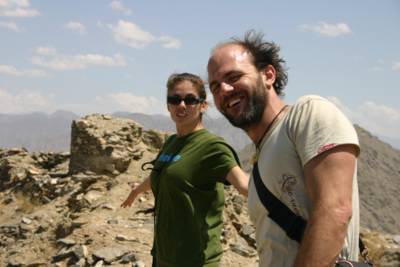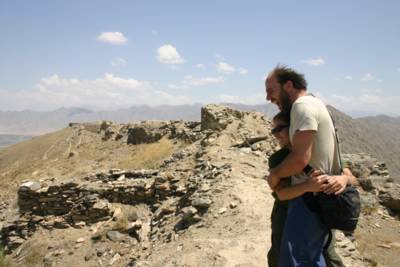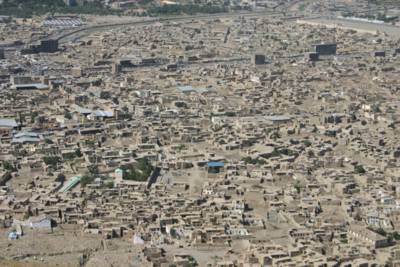A Trip to the Zoo
After yesterday's climb, I was a teeny bit sore, but not too bad. We went out to eat at this restaurant that is owned by some Europeans, and that feels like anyplace but Kabul when you are inside. Cleany, shiny surfaces, trendy lighting and decor, expensive dishes. Apparently it is a place where a lot of the military men hang out, because it meets all of the security specifications necessary to make it always ok (set back from the street X kilometers, walls X meters high, X number of guards, etc). It is supposedly quite the singles scene. I am glad I went with a group.
The food was good, although I kind of got screwed with the bill. I had forgotten what that feels like -- you know, when you are the one person in the group who doesn't make a salary but instead is in a bunch of debt so you order the cheap dish and no appetizer and only have one drink while everyone else orders two or three drinks and apps and then at the end everyone wants to just split the bill evenly which works well for everyone except you who would feel like a jerk be to be the one person to ask to contribute less and so you end up subsidizing everyone else's consumption despite your best efforts to not spend too much on your own. You know the deal. But it was great company and good food, and I thoroughly enjoyed myself nevertheless.
Today I went to the zoo with Ash (one of my fellow hikers from yesterday). I and a woman in a burqa were the only two women there. I got lots of stares. The zoo is not very big, and especially now that about half of the pins/cages/animal areas have been destroyed by the wars, there is not too much to see.
I felt both good and bad about the zoo. Really the only good part was that the people there were really interested in us, and this whole little crowd of grown Afghan men wanted to show us around and talk to us. One of them was very tall and, like most Afghan men, had a dark, stern-looking face beneath his white turban. It was fun and incongruous to watch him put his fingers up above his ears like horns, as he tried to explain the animals to us. Another one was a master of the one English phrase, "Come on!" and used it repeatedly to encourage us to follow them to the next cage.
The rest of the zoo was a big ol' downer. I mean, I have mixed feelings about zoos anyway. I hate to cage up wild animals and restrict them from their natural environments and territories, but if they are well-cared for and if it helps protect endangered species and encourages people to love and respect animals, then that's good. But here, the zoo fails in every respect. The animals are not well cared for. They are in tiny cages (giant bears in a cage the size of a small studio apartment, large birds of prey in cages the same size with no room to fly) and they are clearly hungry and the visitors do not respect them. The areas with the monkeys and the other bears are surrounded by small canals of giardia-infested, green, stagnant water with all sorts of trash and debris floating around in it. The gazelles looked okay. And the "wild boars" seemed to be doing fine (although they are not wild boars at all -- just regular ol' domestic pigs!), even though visitors regularly climb down into their area and tease them. The lions seemed okay (there are two new lions -- there were two previously, but the Taliban threw a grenade into their pit and killed one and took the eye out of the other. the one-eyed lion died last year of kidney failure.) but then again, they didn't move. I noticed that there were many ways that these lions could easily jump over the walls of their little area if they were happy enough, healthy enough, well enough fed. This could not be a very good sign that they were just laying there even though freedom was so easily attainable. The parakeets also seemed to be doing well.
That is about all there is to the zoo. It is kind of surreal to walk around some of the old destroyed parts of the buildings, and see up close like that the destruction of war. There was some graffitti, in English, on one of the old buildings (I imagine it was a reptile house, but don't ask me why) which read, "Long live Mujahudeen of Afghanistan." I wonder who wrote that and when.
We left the zoo and went to Chicken Street, the main commercial street that caters to tourists in Kabul. Carpets, clothing, more animal fur and pelts than you can imagine, jewelry, and some knick-knack stores like the one we went into. It is a metal store, with antique metalworks like rifles ornately carved and decorated with ivory and wood, water pipes, locks, instruments, swords, shields, chain mail, old coins, and anything else made of metal that you can imagine. Pretty neat store, really. The pieces come from all over Afghanistan and all over the world. I am not sure how to judge the quality, but nothing here is as expensive as it is anywhere else, so I am sure you can' really go wrong.
Tonight I will go out to eat at the Chinese Dumpling House and play some ping pong and some cards. A slow Kabul weekend evening.
The food was good, although I kind of got screwed with the bill. I had forgotten what that feels like -- you know, when you are the one person in the group who doesn't make a salary but instead is in a bunch of debt so you order the cheap dish and no appetizer and only have one drink while everyone else orders two or three drinks and apps and then at the end everyone wants to just split the bill evenly which works well for everyone except you who would feel like a jerk be to be the one person to ask to contribute less and so you end up subsidizing everyone else's consumption despite your best efforts to not spend too much on your own. You know the deal. But it was great company and good food, and I thoroughly enjoyed myself nevertheless.
Today I went to the zoo with Ash (one of my fellow hikers from yesterday). I and a woman in a burqa were the only two women there. I got lots of stares. The zoo is not very big, and especially now that about half of the pins/cages/animal areas have been destroyed by the wars, there is not too much to see.
I felt both good and bad about the zoo. Really the only good part was that the people there were really interested in us, and this whole little crowd of grown Afghan men wanted to show us around and talk to us. One of them was very tall and, like most Afghan men, had a dark, stern-looking face beneath his white turban. It was fun and incongruous to watch him put his fingers up above his ears like horns, as he tried to explain the animals to us. Another one was a master of the one English phrase, "Come on!" and used it repeatedly to encourage us to follow them to the next cage.
The rest of the zoo was a big ol' downer. I mean, I have mixed feelings about zoos anyway. I hate to cage up wild animals and restrict them from their natural environments and territories, but if they are well-cared for and if it helps protect endangered species and encourages people to love and respect animals, then that's good. But here, the zoo fails in every respect. The animals are not well cared for. They are in tiny cages (giant bears in a cage the size of a small studio apartment, large birds of prey in cages the same size with no room to fly) and they are clearly hungry and the visitors do not respect them. The areas with the monkeys and the other bears are surrounded by small canals of giardia-infested, green, stagnant water with all sorts of trash and debris floating around in it. The gazelles looked okay. And the "wild boars" seemed to be doing fine (although they are not wild boars at all -- just regular ol' domestic pigs!), even though visitors regularly climb down into their area and tease them. The lions seemed okay (there are two new lions -- there were two previously, but the Taliban threw a grenade into their pit and killed one and took the eye out of the other. the one-eyed lion died last year of kidney failure.) but then again, they didn't move. I noticed that there were many ways that these lions could easily jump over the walls of their little area if they were happy enough, healthy enough, well enough fed. This could not be a very good sign that they were just laying there even though freedom was so easily attainable. The parakeets also seemed to be doing well.
That is about all there is to the zoo. It is kind of surreal to walk around some of the old destroyed parts of the buildings, and see up close like that the destruction of war. There was some graffitti, in English, on one of the old buildings (I imagine it was a reptile house, but don't ask me why) which read, "Long live Mujahudeen of Afghanistan." I wonder who wrote that and when.
We left the zoo and went to Chicken Street, the main commercial street that caters to tourists in Kabul. Carpets, clothing, more animal fur and pelts than you can imagine, jewelry, and some knick-knack stores like the one we went into. It is a metal store, with antique metalworks like rifles ornately carved and decorated with ivory and wood, water pipes, locks, instruments, swords, shields, chain mail, old coins, and anything else made of metal that you can imagine. Pretty neat store, really. The pieces come from all over Afghanistan and all over the world. I am not sure how to judge the quality, but nothing here is as expensive as it is anywhere else, so I am sure you can' really go wrong.
Tonight I will go out to eat at the Chinese Dumpling House and play some ping pong and some cards. A slow Kabul weekend evening.







































